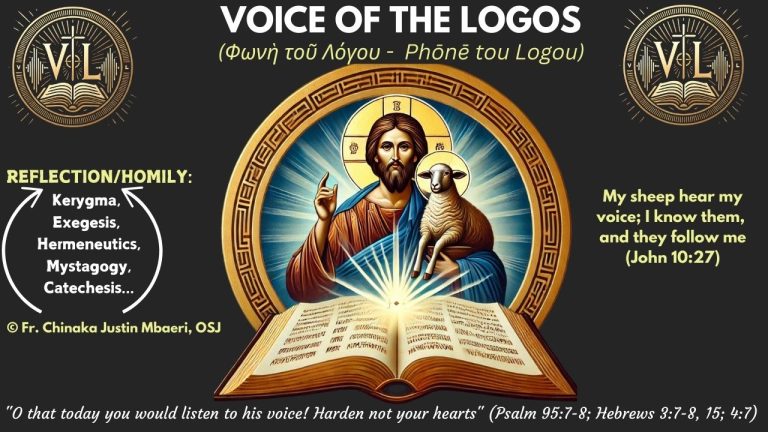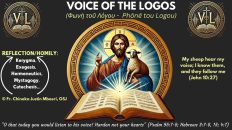Confusing the Sign with the Reality it Points To
First Reading: Acts 7:51-8:1
Responsorial Psalm: Ps. 30(31):3-4,6,8,17,21
Gospel: John 6:30-35
________________________________________
It often happens in life that we become absorbed in outward appearances and signs, losing sight of their deeper meaning. This tendency, so embedded in human nature, was addressed even in antiquity. St. Augustine observed that a sign is not an end in itself but a means that “causes us to think of something beyond.” He warned against becoming attached to the sign while forgetting what it signifies. Later, Martin Heidegger would explain that the true function of a sign is to disclose a path toward Being, not to eclipse it. When signs are properly understood, they lead us into truth; when misused, they obscure it. This misplacement of focus is not new. It reflects a recurring struggle in salvation history, where visible signs meant to aid faith are turned into ends in themselves. It is in this light that today’s liturgical theme invites us to reflect on the tendency to confuse the sign with the reality it points to. Many are drawn to holy objects, events, or spectacular spiritual signs, sometimes forgetting that these are meant to direct us toward communion with the living God. The sign, when separated from the reality it signifies, loses its true purpose. This theme resounds throughout today’s readings: the danger of mistaking signs for substance, appearances for essence, and intermediaries for the One they reveal. This reflection is not about rejecting symbols or signs, but about recovering their role as windows (not walls) into the divine mystery.
In the first reading (from Acts 7:51 to 8:1a), Stephen confronts the religious leaders with piercing words. His speech, culminating in his martyrdom, is a theological critique of a people who revered the Law, the Temple, and sacred customs but failed to recognize the God who gave them. The “Sitz im Leben,” or life setting, of this passage lies in the early conflict between the nascent Christian community and traditional Jewish authorities who clung to the Temple cult and Mosaic customs. Stephen charges them with resisting the Holy Spirit and following the pattern of their ancestors who killed the prophets. Their veneration of the Temple had become hollow because it lacked the openness to the One to whom the Temple was meant to lead. This reflects a key dimension of the theme: confusing the symbol for the reality. The Greek root connected with this confusion is semeion, meaning “sign.” A sign is not the destination but a marker pointing to something greater. The people, however, had turned the sign into an endpoint. They treasured the Law but closed their hearts to its fulfillment in Christ. They revered the Temple but rejected the God who had made it His dwelling.
The responsorial psalm (Psalm 31) continues this thread by shifting the focus to a heart that does not cling to outward signs, but to God Himself. “Into your hands, O Lord, I commend my spirit” is the central prayer of someone who has learned to trust in the reality beyond appearances. The psalmist, probably David in the context of personal distress, calls out, “Into your hands, O Lord, I commend my spirit.” This statement, later echoed by Jesus on the Cross and subsequently by Stephen at the hour of death in the first reading, reflects a surrender not to signs, but to the One whom the signs are meant to reveal. The psalmist does not ask for outward signs of victory or favour, but anchors his hope in the covenantal relationship with God Himself. The movement here is from symbol to substance, from liturgical expression to personal surrender. It challenges us to measure our faith not by the number of religious articles we possess or the frequency of our external devotions, but by the depth of our communion with God, especially in moments of trial and obscurity. The psalm trains the heart to look beyond the veil of signs and rest in the Person behind them.
The gospel reading (from John 6:30 to 35) offers the clearest articulation of this theme. The crowd demands a sign from Jesus, comparing Him to Moses who gave their ancestors manna in the desert. They want bread again, a repeated miracle, something tangible. Jesus redirects their desire: “It was not Moses who gave you the bread from heaven, but my Father gives you the true bread from heaven.” The people ask Him, “What sign can you do, that we may see and believe in you?” They recall the manna in the desert as a proof of God’s favour and demand something similar from Jesus. The historical context is shaped by the Jewish expectation that the Messiah would repeat the miracles of Moses, particularly the provision of heavenly bread. Yet Jesus redirects their desire, telling them that the true bread is not the manna given in the past, but the living bread from heaven – Himself. The Greek word sēmeion appears again in this chapter, used by the crowd to request a sign. Jesus rebukes this mentality, exposing a deeper hunger not just for physical bread but for eternal life. His response, “I am the bread of life,” shifts the focus from the sign to the substance. Thus, Jesus offers Himself as the alēthinos artos, the true bread. The Greek term alēthinos implies something genuine, not just in appearance but in essence. In effect, Jesus says: You are still asking for signs when the Reality to which all signs have pointed is standing before you. Their eyes remained fixed on the miraculous feeding, but failed to grasp its deeper meaning: the Eucharist, the self-gift of Christ. They want the sign of bread, but Christ is inviting them into union with Himself as the Bread of Life. The sign of manna had always pointed forward to a deeper sustenance, but the people could not move beyond the shadow to embrace the reality. Jesus’ declaration confronts a faith built on external expectations and invites a faith rooted in spiritual communion.
This brings several important lessons. First, we must examine whether our spiritual lives are grounded in true relationship with Christ or in attachment to external signs. Holy water, sacramentals, devotions, and images are deeply valuable, but only if they draw the heart toward deeper faith in Christ. When they become ends in themselves, they risk becoming distractions rather than aids. Second, this theme challenges the Church today to purify its catechesis, ensuring that the faithful understand the purpose of liturgy, sacraments, and devotionals as paths to encounter the Lord, not as magical solutions or cultural performances. Lastly, this reflection invites each of us to seek the Giver more than the gift. When our prayers go unanswered or signs do not appear, it is precisely in those moments that faith matures. Like the psalmist and Stephen, we learn to entrust our spirit into God’s hands, finding joy not in what we see, but in Whom we trust. Seeking Christ Himself, rather than merely His signs, is the mark of a mature and authentic faith.
In the end, the Christian life demands that we recover the ability to see signs not as possessions to be clung to, but as invitations to go deeper. Stephen’s martyrdom, the psalmist’s surrender, and Christ’s self-disclosure in the Gospel all remind us that the signs of our faith, whether liturgical, scriptural, or sacramental, are not the final destination. They are entrusted to us as instruments that awaken the heart to God’s self-giving. Augustine’s wisdom remains alive: to love the sign without loving the reality it signifies is to stop halfway on the journey of faith. Heidegger’s perception also challenges us to be attentive to how religious symbols either open or close us to the reality of divine presence. In our time, when superficial attachment to religious expression often replaces inner conversion, we are called to strip away the wrapping and receive the gift. The goal is not merely to admire what points to Christ, but to hunger for Christ Himself. And that hunger is satisfied not in the repetition of outward gestures alone, but in the surrender of the spirit, where sign and substance meet in a living encounter.
O that today you would listen to his VOICE, harden not your hearts! (Ps. 95:7)
____________________________
Shalom!
© Fr. Chinaka Justin Mbaeri, OSJ
Seminário Padre Pedro Magnone, São Paulo, Brazil
nozickcjoe@gmail.com / fadacjay@gmail.com
__________________________
Have you prayed your rosary today?



May GOD give us the grace to understand him and serve him in the right way in our life.
Mother most pure, pray for me and my family
May the Lord help us to pursue substance and not shadows in our daily walk with Him. Amen.
God, give me the wisdom to understand you and to love you for what you are, not just for what I would want you to do for me.